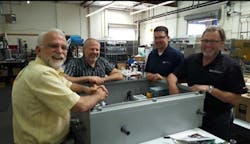Dynamic Distribution
The San Jose Water Co. (SJWC) of northern California provides drinking water for over one million people in the greater San Jose region. As shown by its active participation in the American Water Works Assn.’s Partnership for Safe Water, SJWC is on the leading edge of distribution system water quality improvement.
The Problem
SJWC recognized that regardless of the excellent water quality generated by treatment plants or wholesale partners, a substantial amount of water quality degradation occurred in the distribution system. Furthermore, an ideal point for intervention is the water storage tanks. After an extensive study of its distribution network, SJWC embarked on a plan to strategically boost residual levels in various tanks that their study showed could positively influence residual levels in problematic distribution zones. Some very influential tanks would receive fully automated residual management systems, such as UGSI’s Monoclor residual control system (RCS), which can dynamically manage chloramine residuals by adding and mixing the right amount of chlorine and ammonia based on the tank’s position on the breakpoint curve.
However, other tanks would only need continuous monitoring and periodic chlorine boosting to remedy an intermittent low residual. SJWC and UGSI worked together to create a solution that would provide continuous mixing, remote residual monitoring, and the ability to boost chloramine quickly and safely; the result of this collaboration was the ChemLocker tank boosting system.
The Solution
The ChemLocker system consists of a Tank Shark reservoir mixing system coupled with a chemical-feed cabinet and residual analyzer. The ChemLocker utilizes an eductor delivery system to introduce the hypochlorite and/or ammonia to the Tank Shark mixer, where the reagents are dispersed into a high-energy mixing zone. The Tank Shark platform also serves to support the sampling of internal reservoir water for analysis by the integral residual analyzer. Additionally, all relevant data is made available for monitoring by plant SCADA.
The ChemLocker is built with the ability to quickly connect to a Monoclor RCS chloramine residual trailer for a more sustained boosting campaign that can be seasonal or periodic to deal with a slug of aged water. From an operations standpoint, tank boosting with a ChemLocker system is safe, with no ladder climbing or constant residual testing.
Red Hill Tank 1 with ChemLocker installation.
The Results
With direction from SJWC, UGSI provided a complete design set and turnkey installation for ChemLocker systems at Red Hill tanks 1 and 2. Installation in many more tanks is planned as SJWC implements its overall distribution water quality plan over the next four years. The combination of the ChemLocker boosting system and the automated Monoclor RCS provides a utility with a set of tools to holistically manage its distribution system water quality safely, effectively and economically.
